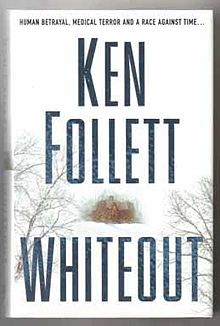Review: Whiteout

Blink once or twice and you might mistake Whiteout‘s opening act for that other ode to mysophobia, The Hot Zone. Coming a full ten years after Richard Preston’s fan favorite, Follett administers a quick shot of déjà vu, retreading familiar themes early on before cracking the lid on a dizzyingly diverse cast and a bioterrorist plot filched straight from a Hollywood screenplay. Whereas The Hot Zone is an uneasy mix of nonfiction gussied up in sensationalist garb, Whiteout is pure novel — and quite the kind for which Follett’s reputation precedes him. While the former fixes its attention almost solely on the pathogen, even idolizing it at times, the latter sculpts its drama around the many characters tangled up in the threatening peril of a diffuse outbreak.
Renowned Scottish pharmaceutical Oxenford Medical specializes in lab-based research on some of nature’s deadliest viruses. The scourge du jour here is the fictitious “Madoba-2,” the deadliest of them all. No one has survived its acquaintance; it is the perfect pathogen. When a narrowly tested vaccine for Madoba-2 goes missing from the Kremlin lab, along with an unwell rabbit reserved for in vivo trials, the company finds itself at the center of a media firestorm. It is the arch responsibility of ex-cop turned Chief of Oxenford Security Toni Gallo to track down the culprit and contain the leak.
With public confidence at an all-time low, the gears of a far more sinister plot are about to be set in motion. Opposite Toni Gallo is the chairman Stanley Oxenford, whose own son is embroiled in a devilish agenda of malfeasance in order to settle his escalating gambling debts. A highly trained unit of heist artists taps Kit Oxenford, a computer wiz who designed the Kremlin’s security system before being fired for lifting funds from the firm’s bottom line, to break in and theft hazardous materials. Desperate to pay off his creditors, and with his life hanging in the balance, Kit finds himself throwing in with a roguish crew whose intentions are unclear. As the holidays descend upon snow-covered Scotland, the Oxenfords gather at Steepfall, the family estate, only to find themselves key players in thwarting an international crisis.
The number of characters introduced as the plot takes shape can feel like a flood, but Follett has the knack for bringing the reader up to speed with well-placed summaries of how each character factors into the immediate scene and reminders of earlier details. While some of the Oxenford clan are standard-issue, many characters turn in quite memorable performances, chief among them Toni Gallo. True to form, Follett invariably reserves the most candescent performances for his strong female leads. While not quite attaining the level of depth and sophistication of Aliena in Pillars of the Earth, Flick in Jackdaws, or Lucy in Eye of the Needle, Toni stands head and shoulders above the rest with her steely resolve and poised demeanor. Her detective training allows her to stay one step ahead of the local constabulary and outsmart the assailants who hauled off with the precious cargo.
The book is not without its faults. An early scene at the family estate borders on soap opera melodramatics and seems out of place in a Follett novel. That the security system wasn’t changed — right down to the thumbprint software on the BSL-4 chamber and the passcodes on the virus lockers — following Kit’s departure from the company reeks of dubious plausibility. A few of the twists and turns feel forced and wrap up a bit too neatly, leaving one to wonder how a more organic progression might have played out. And, though many may neither care nor notice, some of the finer points on the science side of things skew toward the problematic.
The Science of Whiteout
As part of his research, we’re told in the addendum, Follett visited biosafety facilities in Manitoba and London and corresponded with a few biosecurity professionals. Had he consulted virologists as well, he might have brought greater accuracy to the details surrounding Madoba-2 and its supposed cousin. The science in Whiteout, what little of it there is, for the most part is not bad, but, like Richard Preston before him, gives a misleading picture of Ebola.
Madoba-2 is frequently compared to the Ebola strain and even referred to as a “variant” of Ebola on one occasion. But the descriptions of Madoba-2 are at odds with what we know about the biology of Ebola and how it has adapted to circulate among human populations. Madoba-2 is airborne, so much so that the terrorists choose a perfume bottle as the delivery mechanism.
Ebola, meanwhile, is a close-contact germ; its proteins prefer to hole up in fluids like blood, saliva, feces and urine rather than in its host’s respiratory pathways. To speak of a virus that wafts on clouds of aerosol droplets emitted by a cough or a sneeze — à la influenza — is to speak of a fundamentally different virus from the strain that’s been ravaging West Africa since December 2013. Suffice to say that if Ebola were even a little like Madoba-2, the current epidemic would be global, not confined to regions with poor medical infrastructure.
Lastly, Madoba-2’s level of efficiency is unexampled in nature. With a human mortality rate of 100%, Madoba-2 is clearly not of this world. A non-free-living organism that killed too efficiently would jeopardize its ability to spread to new hosts. Dead hosts are like wet gunpowder, an evolutionary endgame. With every pathogen we’ve encountered, some portion of the susceptible population is resistant and passes on its immunity to successive generations. That is, until the virus adapts to the new regime and the cycle repeats. Even Ebola, among the deadliest viruses known, has topped out at 90% mortality in some populations. All considered, Madoba-2 sounds more like something engineered by man than something that would arise naturally.
Closing Thoughts
You’re always in good hands with Follett. The brigadier general of historical fiction delivers another suspenseful tale worthy of the big screen, this time cutting his teeth on the killer virus motif in modern-day Scotland. While this may stray outside Follett’s typical genre, all of the key elements are ported over intact. Thanks to its intriguing characters, smooth pacing and a Costco’s worth of page-turning tension without an excess of sex or violence, Whiteout joins a rich legacy of polished narrative that leaps off the page with ease. Settle in for a night of frosty weather, dueling ambition, budding romance, and a high-strung thriller just compelling enough to dispel disbelief. A fine choice for your next weekend away.
Note: This review is mirrored over at Goodreads and at Amazon.



Comments